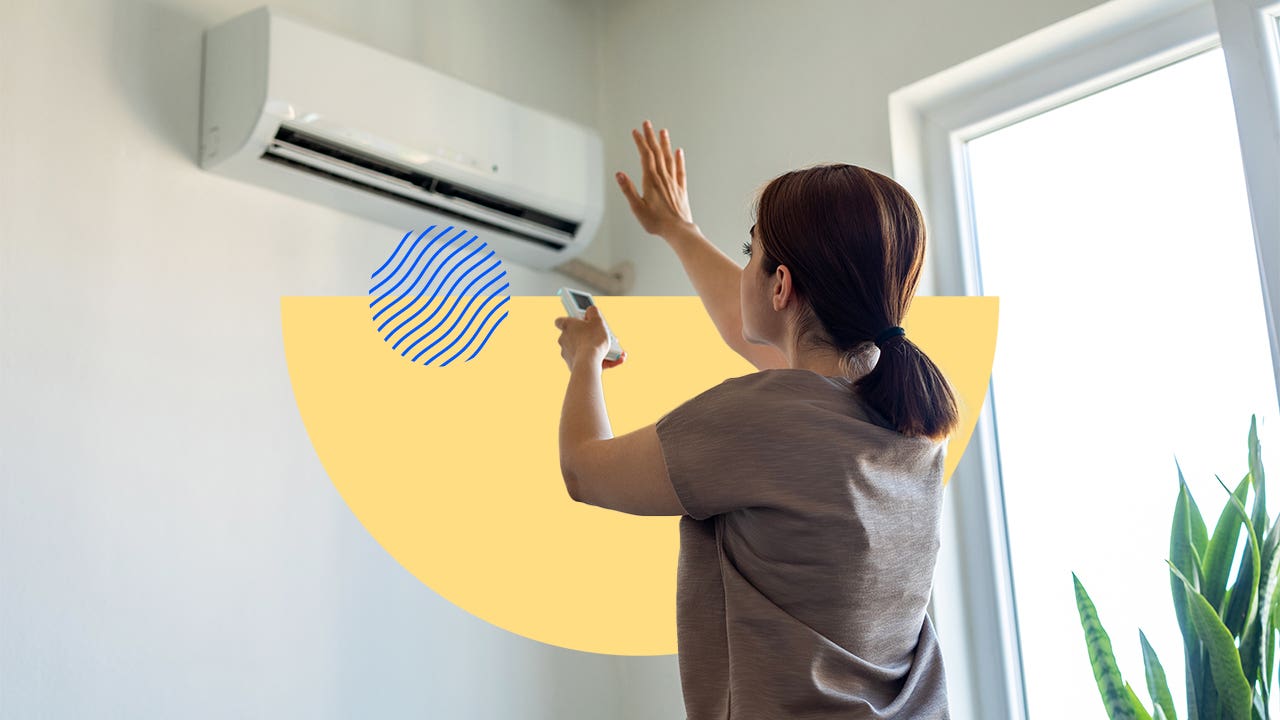12 ways to save on air conditioning costs

The Bankrate promise
At Bankrate we strive to help you make smarter financial decisions. While we adhere to strict , this post may contain references to products from our partners. Here's an explanation for .
It’s possible to keep your home cool this summer without causing your electric bill to overheat too much.
Nearly 90 percent of American homes have air conditioners, and AC units consume six percent of all the electricity produced in the United States, costing homeowners $29 billion annually, the U.S. Department of Energy (DOE) reports.
U.S. households are expected to spend about $176 per month on electricity bills over June, July and August 2023, according to the U.S. Energy Information Administration (EIA). And a big chunk of that will go toward running the AC as temperatures soar in the summer months. Air conditioning accounts for about 12 percent of monthly power bills, and as much as 27 percent in hot, humid states like Florida or Louisiana, according to the latest federal data.
The bad news is that the summers are likely to only get hotter. Climate change is already placing a larger burden on our electrical grids, according to the Environmental Protection Agency, and is expected to continue to do so. The result: an 8 to 13 percent increase in energy demand from air conditioning usage in the next decade, the American Geophysical Union predicts.
Many utility companies routinely raise their rates in summer, and this year Americans will probably spend about 2 percent more, on average, on their monthly electricity bill, the EIA predicts.The good news? There are ways to cut the cost of cooling your home without busting your budget or wiping out your savings. Here are some ways you can save money on your air conditioning and thus your electric bill.
1. Throw some shade around the house
Planting leafy trees around the outside of your home will help block the sun and keep your house cooler.
“Most heat that accumulates inside a house comes directly from the sun shining onto the roof or through windows and heating the house directly,” says John Krigger, founder and president of Saturn Resource Management in Helena, Montana. Krigger, an energy conservation specialist, writes books, lectures and trains others in energy conservation for buildings.
Krigger says to plant tall trees on the south side of the property and broad trees to the west and east. “If you have a large window facing east or west, you’re going to get a lot of sun in the morning and afternoon and solar rays are coming from low in the sky,” he says, while solar rays are high in the sky on the south side.
“It’s worthwhile to spend the extra money to buy a tall tree, if you put the tree in the right place,” Krigger says.
2. Cover your windows
In general, about 30 percent of a home’s heating or cooling energy is lost through windows. In summer, about 76 percent of sunlight on windows enters in the form of heat, according to the DOE. Solar screens, or mesh-like window screens, can intercept the energy before it gets into the house. Window screens are particularly effective on east- and west-facing windows.
“If you can install them on the outside, that is the way to do it,” Krigger says. “That would stop [solar energy] before it got completely through the glass. It’s better than anything you can do on the inside.”
Window films are another money-saving option. They are metalized sheets that reflect heat before it can be transmitted through glass. “Using something white or silver, something that is very reflective, will stop it getting through the glass,” Krigger says.
Of the two, the screens have an advantage. Windows must be shut for window films to work, but solar screens keep out sun and insects even with the windows open.
Window treatments also go a long way. Just keeping curtains drawn or blinds down can keep rooms cooler, so your AC doesn’t have to work as hard. But for maximum impact, consider investing in solar window shades, which are coated with a material that effectively blocks most UV rays from entering your home. They will keep your furniture from fading from direct sunlight and keep your electricity bill lower.
3. Get smart about your thermostat
If you haven’t done so already, it might be time to switch to a programmable or smart thermostat that can be set to adjust the temperature in your home at certain hours of the day. Smart thermostats enable you to maintain a comfortable temperature in your home and many of them can be operated remotely — even from your smartphone. They cost on average $300 or so, according to Fixr.com.
Keep your programmable thermostat set as high as is comfortable (the DOE recommends 78 degrees Fahrenheit), and when you’re away from home, set the temperature even higher. You can trim 10 percent off your energy bill by setting your thermostat by 7 to 10 degrees higher for eight hours a day, the DOE estimates.
And don’t drop it down to a super-low temperature after being gone all day. Doing so doesn’t cool your home any faster and can result in excessive cooling and a bigger power bill at the end of the month.
The location of the thermostat is also important. To work efficiently, it should be on an interior wall away from direct sunlight, drafts, doorways, skylights and windows, according to the DOE. And don’t place furniture or curtains where they would block AC vents.
Another trick: Set the AC fan speed on high, except on very humid days, the DOE recommends. On humid days, set the fan speed on low. Why? The slower speed will remove more moisture from the air and improve the comfort of your home.
4. Install ceiling fans
If possible, run ceiling fans on your home’s upper level and open the windows on the lower level. If you live in a one-story house or apartment, close windows near the fan and open windows in rooms far from the fan, preferably on your home’s windward side, the DOE advises. The key, Krigger says, is to circulate air inside the house.
By running a ceiling fan, you can raise your thermostat setting by about 4 degrees without compromising your comfort level. In the summer, run ceiling fans in a counterclockwise direction, and turn off fans when you leave a room.
Moving air also helps evaporate the sweat from your skin, says Montpelier, Vermont-based energy consultant and author Paul Scheckel of Parsec Energy Consulting. “Evaporational cooling is an incredibly efficient process for removing heat, and our bodies do it all by themselves,” he says. “A little help can increase the cooling effect.”
5. Service your AC
It’s an upfront investment – and not a glamorous one– but keeping up with routine maintenance on your air conditioning unit can help reduce its energy consumption. Clean filters alone can trim your unit’s energy use by 5 to 15 percent, according to the U.S. Department of Energy.
Filters may need more frequent cleaning or replacing if there is a lot of dust or if you have furry pets. A clogged or dirty filter blocks airflow and reduces the efficiency of the unit. “Keep the filter clean to allow for good air movement and keep the unit level so the condensation drains properly,” advises Scheckel.
The coils in the evaporator and condenser also collect dirt and dust and need periodic cleaning. The coils in the outside condenser can trap leaves, twigs and other debris. Trim foliage near the unit and keeping the area around the condenser free of dirt and debris.
Check the coil fins to make sure they’re not bent and blocking air flow.
A recent “Summer Cooling “survey by DuraPlas, a plastics manufacturer, found that only 30 percent of homeowners schedule preventative maintenance on their AC units, but doing so can pay off. Ensuring your unit and air ducts are clean are proactive ways you can ensure optimal home energy efficiency for warm summer months.
30%
Source: Energy.gov
6. Go with a state-of-the art cooling system
If your AC system is old, odds are it’ll be less efficient and break down more. You can cut your energy costs by swapping an old air conditioner for a new unit with a high energy-efficiency ratio, or EER, found on Energy Star-qualified units. Energy Star is a system used by the U.S. government to designate energy-efficient products; the higher the rating, the better the system.
Krigger says to consider the climate you live in before buying an air-conditioning system. For example, evaporative coolers, while much more economical than central AC units, are not suited for humid climates like Florida, but work well in hot, dry places like Arizona.
“It’s easier to cool a house in a dry climate,” Krigger says. “In a humid climate, it’s not so easy. The amount of water you have around your house really affects the AC.”
Krigger says individual AC units and ductless AC units, including ductless mini-splits, are much cheaper to use than central AC units. “With central AC with ducts, the reason they are so inefficient is we just haven’t paid enough attention to how much ducts leak,” he says. “Sometimes, 30 percent or more of the energy is leaked out of the ducts.”
Krigger says a single or ductless system can be 50 percent to 60 percent cheaper than central air conditioning. “People are pretty desperate to save money right now and that’s a great way to do it,” he notes.
While it’s a much bigger investment, you might also consider installing a heat pump — which, despite the name, cools your home in summer by transferring heat, somewhat like a refrigerator. In fact, mini-split heat pumps (which don’t require ductwork, making them a relatively easy install), were among the most-requested energy-efficient HVAC systems cited by the construction pros polled in Fixr.com’s “Residential Energy Efficiency Report 2023.”
7. Seal the leaks
A drafty house is not an energy-efficient house. Do a visual check inside and outside the home for gaps, cracks and openings where air can come and go. Windows and doors are the obvious places to check, but there are many other areas that are prone to leaks, such as where the home’s foundation meets the exterior brick or siding.
For a thorough assessment of your property, hire a professional technician for an energy audit. A professional can find energy-inefficient leaks where you might not think to look and can tell you where more insulation is needed.
8. Avoid using the stove and oven
You might think your air conditioner just has to strain on hot days, but it can be forced to do more work when you create heat, too. That includes using major appliances like your stove or oven. Consider only using them at night when the temperature is cooler. If feasible, you could even consider building an outdoor kitchen; it’ll still use energy, but it won’t contribute to your air conditioner working overtime.
Other home-cooling tips: Turn on the kitchen exhaust fan after cooking. Run the bathroom exhaust fan after a hot shower to help the heat dissipate. If you have room, construct an old-fashioned clothesline and hang your laundered garments outside to dry instead of using the hot dryer inside your house.
9. Head for the basement
It’s common knowledge that heat rises. So, it makes sense to camp out in the basement if you have one. Just don’t open basement windows when it’s humid. “Warm, moist air will cause condensation on cool surfaces, such as basement walls, ultimately increasing the humidity in your home,” Scheckel says.
For comfort, you might want to install a dehumidifier in the basement.
10. Open windows, close doors ventilate strategically
Learn to ventilate strategically. If you live in a climate where the temperature drops after sundown, consider turning your air conditioner off and letting the breezes cool your home after dark. Open the windows overnight. (Almost one-third of the DuraPlas poll respondents were trying this trick.)
Admittedly, this strategy may not suit those in the South or Midwest. But residents in any region can also remember to seal off rooms that they’re not actively using. Closing doors and vents can help to redirect chilled air toward the areas you’re spending time in, so you aren’t paying to cool empty parts of your home. This can help to keep cooling bills lower around the clock.
11. Unplug devices not in use
This tip can save you money year-round, and not just on air conditioning costs. But in warmer months when your energy bill is already likely to be at its highest, unplugging devices and appliances that aren’t in use can help you to shave dollars off your electricity usage.
If you use mobile or window-unit air conditioners in your home, unplug them completely when you don’t need them. Doing this every time you leave the house is likely not the most efficient choice (energy or otherwise), but if you’re leaving for a week-long trip or vacation, unplugging ACs and other appliances (consider your television, desktop computer or gaming system) can trim your energy bill significantly while you’re away.
12. Ask your electric company about assistance
Some energy giants offer bill payment assistance to their customers. New York-based ConEdison, for example, is offering monthly discounts to customers who are on Social Security and some other government assistance programs.
North Carolina-based Duke Energy has a number of customer assistance programs. Pacific Gas & Electric Co., the San Francisco-based utility giant, also features reduced rates for eligible customers.
Some utility companies allow you to pay the same amount every month over the full year to avoid huge spikes in your bill during cooling seasons.
Visit your utility company’s website or give them a call and ask about discounts, budget billing and other options that could help you reduce your AC costs this summer.
Related Articles



